Positive Health Online
Your Country

Shiatsu, Nutrition and Mind in the Treatment of ME
by Mike Webster (Deceased)(more info)
listed in shiatsu, originally published in issue 66 - July 2001
Having survived ME (myalgic encephalomyelitis) myself, I have experienced first-hand the devastating effects, the impact it has on the life of the sufferer and the understanding required from family and friends. This experience has enabled me to devise a programme of treatment for each individual using a variety of skills, involving them in a strategy which remo the frustration and stress of being advised to just 'sit and wait'.
This treatment for ME sufferers is completely individual and falls into three main categories:
1. Shiatsu;
2. Nutrition;
3. Mental strategy.
Shiatsu
Shiatsu literally means 'finger pressure', and every treatment is preceded by an in-depth case history.
The severity of the illness and potential recovery time can usually be estimated by gently pressing certain areas of the abdomen. This form of diagnosis is called a hara diagnosis, used mainly by Shiatsu practitioners, and is also used as a means of monitoring progress at the beginning of each treatment, which is carried out fully clothed in a warm room, usually on a futon (thick padded mattress) on the floor.
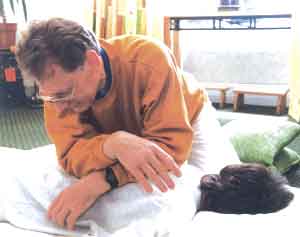
A comfortable position for therapist and client when working the lower lumbar region
The hara diagnosis, which was developed by Shisuto Masunaga, a doctor of psychology and shiatsu master, consists of gently pressing the soft organs within the abdomen. This explores the dynamics of energy within the body and the human energy field, which should be in a state of continuous movement, expansion and contraction, and transformation.
The continuous movement of expansion and contraction is known as kyo-jitsu (kyo – expanded; jitsu – contracted). In health the exchange is continuous, but in physical/mental illness a pattern becomes fixed and unmoving, systems within the body try to compensate and symptoms arise.
As the pattern becomes more long term and fixed (the natural movement of energy gravitating towards a denser body), symptoms worsen and the body/mind now deteriorates and the illness becomes steadily entrenched. As a general rule, the more 'jitsu' to be found within the hara the greater the potential for early recovery, and the hara diagnosis also indicates the areas that will be more responsive to treatment.
In ME there appear to be two main energy categories: 'deficient' and 'bound up'.
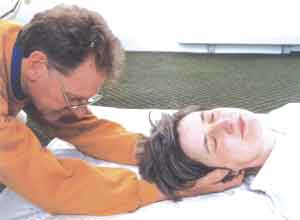
Releasing tension in the neck whilst activating responsive points at the base of the skull
Deficient Energy
The totally deficient client will appear to have no signs of life within the hara – resilience nil. Unnecessary movement of limbs, stretching and rotating have a detrimental effect, using up vital energy. A strong treatment would be like trying to move a car away from a standing position in top gear, stalling the car – energetically stalling the client who would be drained and exhausted after the experience.
Sessions are initially short and quite specific with little movement of the client's limbs, and treatments are centred on energetically responsive areas that are recognized by the experienced practitioner.
With shiatsu, unlike acupuncture, 'tsubos' or 'acupuncture points', are not limited to those which are to be found neatly numbered and catalogued and placed on charts for all to see. Points manifest like hot springs on the body and are readily recognized by the trained practitioner.
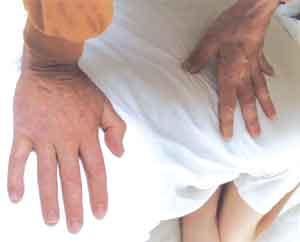
Active and responsive points on the bak stimulate specific 'systems' into action
The areas that are stimulated (mainly by thumb pressure) are left alone if they are not immediately responsive, as persistence on the part of the therapist will, in this case, tire the client, as will long sessions at this early stage in treatment. All small pockets of energy that may be classed as 'jitsu' (or contracted energy) are considered 'good news' and left alone for the time being. Once there are signs of improvement in the client's condition these pockets of jitsu will be called upon to play their part in raising the energy levels of the client and assist in the process towards health.
Bound-up Energy
Treating the 'bound up' client is an easier proposition for the therapist. Energy is usually held in tension in the upper body, neck, shoulders and back – nothing moving. The approach to treatment is markedly different from the deficient client. The polarity of kyo-jitsu is well marked and fixed; energy is not available for use. Freeing this off is the first step to re-establishing the natural flow of expansion and contraction. Once freed and moving, stimulation of the energetic system is the next step.
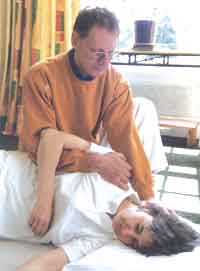
Easing out tension in the neck
Case Study – Part 1
Sarah, a college lecturer, had ME for eight years before treatment and wasn't able to cope with work – the long hours involved with teaching and the preparation. She was also preparing for her Master's degree in Business Studies, working long into the night. Time off work with illness put her job on the line, so something needed to be done, and now!
Sarah's ME was of the deficient type. Her initial diagnosis of was of kidney and spleen deficiency. The 'kidney' diagnostic area in psychological terms suggested anxiety, stress and mental depletion, lack of drive and overwork. The diagnostic area of 'spleen' showed lack of support from family and work, and also an inability to think clearly or absorb information. On a more physical level, she suffered from back pain, poor nutritional absorption, food intolerances (wheat in particular) and lethargy.
Short specific shiatsu treatments stimulated her body into recovery. Initially, treatments were carried out with the minimum of movement. There were no rotations or stretches for the first few treatments, but gradually, as Sarah's energy started to return, treatments although still short became more stimulating, bringing her body and mind back to life.
The first signs of recovery are within the mind – a realization and a feeling that you can do more than you are doing. This is quite different from the feeling that you have to do more. This is a time for celebration but also one of restraint as the road to recovery opens up in front of you, and your new-found energy and motivation push you to do more than your body is capable of sustaining. It is a time for conservation.
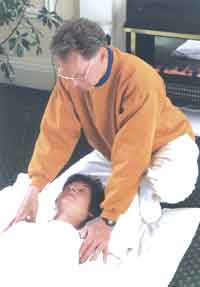
Particular care and sensitivity is required when working the chest, a seat of emotion
Nutrition (Individual Clinical Nutrition Profile)
An individually tailored nutritional programme is prepared for the client, comprising dietary changes where required and a supporting programme of nutritional supplementation. Clients are usually lacking, for example, sufficient amounts of the B vitamins, which are needed, amongst a range of important tasks, for the health of the immune system, and minerals such as zinc and magnesium, which are poorly absorbed in ME. Not only does this support the work of the shiatsu treatment by aiding the rebuilding of the immune system, the body and the mind, but it is also an area where the client can take an active part in their own recovery.
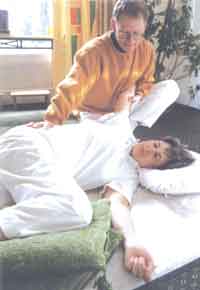
As the client moves along the road to recovery, appropriate stretching improves energetic change,
accelerating the healing process within the body/mind
Case Study – Part 2
Sarah's nutritional requirements for recovery were simple to diagnose. Amongst other problems that were in evidence, a profile highlighted that her body was unable to convert simple sugars into energy, and low levels were stimulating the release of adrenaline. Her diet consisted mainly of bread and wheat products, which convert to simple sugars very quickly and cannot be converted into energy which is stored mainly in the liver. A shift to complex carbohydrates, in the shape of selected whole vegetable foods and easily digestible protein, allowed her body to process the foods needed for the recovery of her immune system, whilst supplying the needs of the rest of her body/mind without overburdening it.
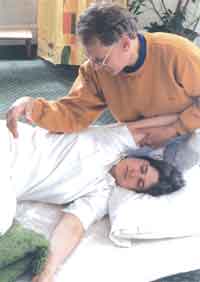
A stretch in combination with an active point (stimulated by the elbow), a good combination for creating energetic change
Mental Strategy
Moving away from the 'rest, wait and see' approach to ME, the client is given a tactical approach to combating the illness. As with the nutritional programme, it is something they can do; waiting is turned into something positive, giving the client a degree of control over the progress of their illness as, with growing confidence, they take an active part in facilitating their own recovery.
Case Study – Part 3
Sarah's feelings of inadequacy had placed her in a vulnerable position, making her take on extra tasks which were pressed upon her, tasks that she was incapable of completing within her overwhelming workload even in good health – the final straw! Feelings of guilt pushed her further down the path to debilitation and overwhelming lethargy. She had to learn to say NO! This is one of the most difficult areas on the road to recovery, as ME often strikes those who are the most conscientious and keep going despite how debilitated and ill they feel. Sarah learned to prioritize and with this came the realization that she was the one who had to make the choice between recovery and prolonged illness. Only she could decide that she was not able to take on more than she was capable of achieving and therefore only she could say NO! This realization enabled her, once again, to take charge of her life, taking back control once more, placing one foot before the other on the road to recovery.
Post-treatment
Treatments finish with a realistic appraisal of the client's present state of recovery, and also any adjustment that may be needed to diet or strategy. It is made perfectly clear to the client from the beginning of treatment that their full commitment and co-operation is required in order that any progress towards recovery is initiated and then maintained.
Diets are expected to be adhered to and the constant battle against using up that 'burst' of energy has to be maintained, at least for the time being. Where lapses occur, progress is monitored by the length of time needed to recover – the shorter, the better!
With continuing progress towards recovery, time between shiatsu treatments is extended, with dietary adjustments as required. The strategy is reinforced in order that there is no slipping back, once again, to an unacceptable view of themselves and their illness. Once self- empowered and armed with the tools of recovery, there is no looking back to the time they felt they would never forget.
Case Study – Part 4
Sarah has now left the teaching profession and embarked on the adventure of a lifetime, which will tax her physical abilities to the limit, an adventure which would tax the physical capabilities of someone half her age. After six months at sea, Sarah is having the time of her life. She has no wish to return to a normal job and her ME is no longer in evidence. She is once again her own person, living, controlling and enjoying her own life.
Further Information
Information regarding Energy Masters, training, consultations and treatment can be obtained on tel: 01389 742664; mwebs@Waveform.fsnet.co.uk
Comments:
-
No Article Comments available